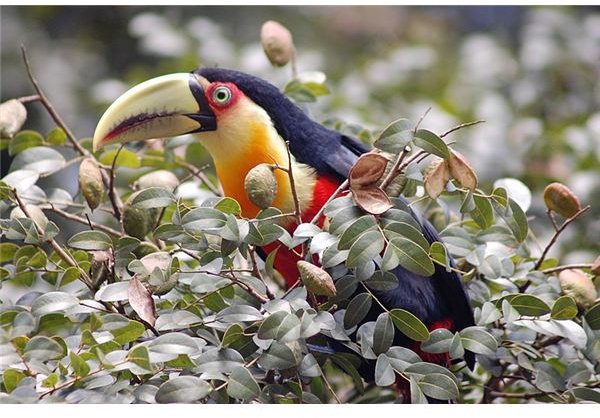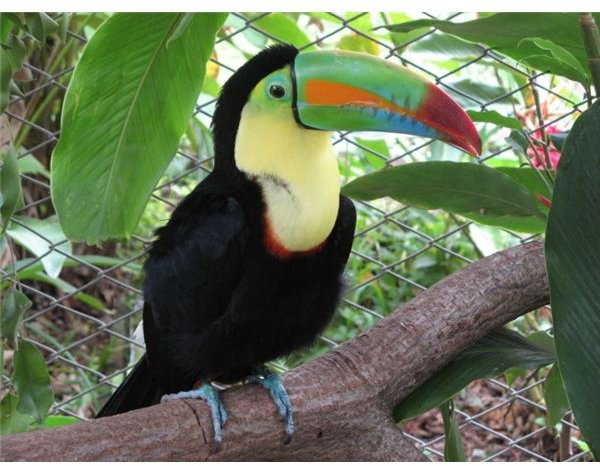Interesting Toucan Facts: Habitat, Biology & Behavior
Meet the Toucan
Forget the characterized toucan you see on cereal boxes—toucans come in all shapes and sizes. There are five genera and about 40 species of toucans, ranging from the jay-sized toucanet to the 24 inch toco toucan.
All toucans are distinguished by their large serrated beak and bright, distinct coloration. Most known by its enormous colorful beak, the toucan’s beak may comprise over half of a toucan’s body length. The beak of a toco toucan is seven and a half inches long. The toucan’s beak is made mostly of keratin layers, the same protein that makes up fingernails.
Scientific Classification
Kingdom: Animalia
Phylum: Chordata
Class: Aves
Order: Piciformes
Family: Ramphastidae
Genus: Toucans are classified into five genuses–
Ramphastos—typical toucans like the toco toucan, Andigena—mountain toucans, Pteroglossus—toucans known as aracaris, Aulacorhynchus—green toucanets, Selenidera—dichormatic (sexually dimorphic) toucanets
Biology and Habitat

Toucans and toucanets can be found in the lowland subtropical and tropical forests of Central and South America. They are most commonly found in dry semi-open areas that consist of scattered trees, which include regions such as woodland, savanna, and plantations.
Toucans lay one clutch of two to four eggs per year. Since toucans have very limited ability to carve into even rotting wood, they are dependent upon ready-made holes for their nests. They typically create unlined nests in tree cavities or abandoned woodpecker holes. The cavities chosen must be safe and large enough for them to fit inside. Once found, they appear to occupy the same cavity for their nests year after year. The incubation period lasts around 17-18 days with both parents taking turns incubating the eggs.
Since both males and females have the brightly colored, long beak—meaning it is not sexually dimorphic—it’s not used as a tool in attraction. The beak helps obtain fruit from high branches and can be used to intimidate smaller birds. Toucans have long, gray tongues that may be up to six inches in length. Toucans have several tail vertebrae fused to their spine that allows them to pull their tail near their head.
Behavior and Diet
Toucans are gregarious. They flock together in large groups that can be downright noisy. They can be heard squawking, chattering, barking, and making all sorts of sounds against the forest background.
They like to perch high in trees can be seen feeding their companions or preening them with their long beaks. Toucans are intelligent birds that enjoy playing games, like beak wrestling. A toucan mating ritual involves picking and throwing food to each other with their beaks.

A toucan’s bill is sharp and has saw-like edges to open fruit with. The toucan diet largely consists of fruit and toucans will use their beak to get fruit from trees. They will also eat insects, spiders, lizards, eggs, and even other birds’ nestlings. The toucans put the food in the tip of their bill, give their head an upward jerk and at the same instant open their mouths, thereby tossing the berry or other food item into the back of their throat. To feed, they often jump or hop from branch to branch.
When they sleep, they turn their heads around and tuck their bills under their wings and tail, making them appear to be a ball of feathers. It is widely assumed that this is so they can sleep in the holes in trees.
Toucans can live for 20 years in the wild.
Conservation
Even though toucans are not listed on the endangered species list, they are threatened by humans who capture them for pets, which is a popular trade in some areas.
They are also threatened by deforestation. Toucans are very important to rainforest ecology because they help to disperse seeds from the fruits and berries they eat.
Whether you are a student or a bird lover, learning these toucan facts is certainly to amaze you! Read more in the reference section about this truly fascinating bird; future research on the toucan will only increase our understanding of its magnificence.
References
Animals of the Rainforest: https://www.srl.caltech.edu/personnel/krubal/rainforest/Edit560s6/www/animals/toucanpage.html
Myers, P., R. Espinosa, C. S. Parr, T. Jones, G. S. Hammond, and T. A. Dewey. 2008. The Animal Diversity Web (online). Accessed March 26, 2011 at https://animaldiversity.org
Sedgwick, Carolyn. 2010. Toco Toucan (Ramphastos toco), Neotropical Birds Online (T. S. Schulenberg, Editor). Ithaca: Cornell Lab of Ornithology; retrieved from Neotropical Birds Online: https://neotropical.birds.cornell.edu/portal/species/overview?p_p_spp=302936
Skutch, A. 1988: https://elibrary.unm.edu/sora/Auk/v088n02/p0381-p0396.pdf